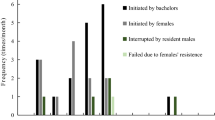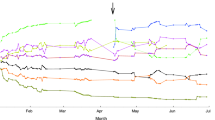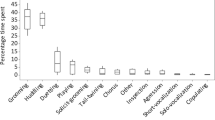Abstract
We studied affiliative behaviors that occurred within and between one-male units (OMUs) in a band of Sichuan snub-nosed monkeys (Rhinopithecus roxellana) living in the Qinling Mountains, China for 3 years from 2002 to 2004. During the birth season, females handling infants of other females affiliatively interacted with females in neighboring OMUs as well as with females in their own OMU. After these interactions, affiliative encounters occurred without conflict between the OMUs. In the mating season, females sometimes presented their genitals to males of other OMUs. These interactions may facilitate the maintenance of a higher level social organization, a band. Therefore, the band composed of OMUs and all male group(s) is the basic unit of social structure of this species. Almost all other Asian colobines have OMUs that either maintain distance from each other or engage in territorial defense, so these OMUs would not be expected to form a band. Contrary to these species, the 3 species of Rhinopithecus spp. inhabiting China form a band composed of OMUs, because infants and females may function as a bridge connecting OMUs.

Similar content being viewed by others
References
Bleisch W, Cheng AS, Ren XD, Xie JH (1993) Preliminary results from a field study of wild Guizhou snub-nosed monkeys (Rhinopithecus brelichi). Folia Primatol 60:72–82
Brent LJN, Teichroeb JA, Sicotte P (2008) Preliminary assessment of natal attraction and infant handling in wild Colobus vellerosus. Am J Primatol 70:101–105
Cui LW, Huo S, Zhong T, Xiang ZF, Xiao W, Quan RC (2008) Social organization of black-and-white snub-nosed monkeys (Rhinopithecus bieti) at Deqin, China. Am J Primatol 70:169–174
Grueter CC, van Schaik CP (2010) Evolutionary determinants of modular societies in colobines. Behav Ecol 21:63–71
Kawai M, Dunbar RIM, Ohsawa H, Mori U (1983) Social organization of gelada baboons: social units and definitions. Primates 24:13–24
Kirkpatrick RC, Long YC, Zhong T, Xiao L (1998) Social organization and range use in the Yunnan snub-nosed monkey Rhinopithecus bieti. Intr J Primatol 19:13–51
Kummer H (1984) From laboratory to desert and back—a social system of hamadryas baboons. Anim Behav 32:965–971
Maestripieri D (1994) Social structure, infant handling and mothering styles in group-living old world monkeys. Int J Primatol 15:531–553
Matsuda I, Kubo T, Tuuga A, Higashi S (2010) A Bayesian analysis of the temporal change of local density of proboscis monkeys: implications for environmental effects on a multilevel society. Am J Phys Anthrop 142:235–245
Murai T (2004) Social structure and mating behavior of proboscis monkey Nasalis larvatus (Primates; Colobinae). PhD thesis, Graduate School of Environmental Earth Science, Hokkaido University
Newton PN, Dunbar RIM (1994) Colobine monkey society. In: Davies AG, Oates JF (eds) Colobine monkeys: their ecology, behaviour and evolution. Cambridge University Press, Cambridge, pp 311–346
Qi XG, Li BG, Ji WH (2008) Reproductive parameters of wild female Rhinopithecus roxellana. Am J Primatol 70:311–319
Ren RM, Su YJ, Yan KH, Li JJ, Zhou Y, Zhu ZQ, Hu ZL, Hu YF (1998) Preliminary survey of the social organization of Rhinopithecus roxellana in Shennongjia national nature reserve, Hubei, China. In: Jablonski NG (ed) The natural history of the doucs and snub-nosed monkeys. World Scientific, Singapore, pp 269–277
Ren RM, Yan KH, Su YJ, Zhou Y, Li JJ, Zhu Z, Hu Z, Hu Y (2000) A field study of Rhinopithecus roxellana. Beijing Univ Press, Beijing (in Chinese with English Summary)
Ren BP, Zhang SY, Xia SZ, Li QF, Liang B, Lu MQ (2003) Annual reproductive behavior of Rhinopithecus roxellana. Int J Promatol 24:575–589
Vogel C (1984) Patterns of infant transfer within two groups of common langurs (Presbytis entellus) near Jodhpur: testing hypotheses concerning the benefits and risks. In: Roonwal ML, Mohnot SM, Rathore NS (eds) Current primate researchers. Jodhpur University Press, Jodhpur, pp 361–379
Wada K, Ogawa H (2009) Identifying inter-individual social distances in Japanese monkeys. Mammalia 73:81–84
Yeager CP (1992) Proboscis monkey (Nasalis larvatus) social organization: nature and possible functions of intergroup patterns of association. Am J Primatol 26:133–137
Yeager CP, Kool K (2000) The behavioral ecology of Asian colobines. In: Whitehead PF, Jolly CJ (eds) Old world monkeys. Cambridge University Press, Cambridge, pp 496–521
Zhang P, Li BG, Wada K, Tan CL, Watanabe K (2003) Social structure of Sichuan snub-nosed monkeys (Rhinopithecus roxellana) in the Qinling mountains of China. Acta Zool Sinica 49:727–735 (In Chinese with English summary)
Zhang P, Watanabe K, Li BG, Tan CL (2006) Social organization of Sichuan snub-nosed monkeys (Rhinopithecus roxellana) in the Qinling mountains, central China. Primates 47:374–382
Zhang P, Watanabe K, Li BG (2008a) Female social dynamics in a provisioned free-ranging band of the Sichuan snub-nosed monkey (Rhinopithecus roxellana) in the Qinling mountains, China. Am J Primatol 70:1013–1022
Zhang P, Watanabe K, Li BG, Qi XG (2008b) Dominance relationships among one-male units in a provisioned free-ranging band of the Sichuan snub-nosed monkeys (Rhinopithecus roxellana) in the Qinling mountains, China. Am J Primatol 70:634–641
Zhao DP, Li BG, Li YH, Wada K (2005) Extra-unit sexual behaviour among wild Sichuan snub-nosed monkeys (Rhinopithecus roxellana) in the Qinling mountains of China. Folia Primatol 76:172–176
Acknowledgments
Drs. Michael A. Huffman and Yamato Tsuji of the Primate Research Institute of Kyoto University carefully revised our paper and gave us valuable suggestions concerning biological points. Drs. Hideshi Ogawa, Yongcheng Long and an anonymous reviewer provided many valuable and candid suggestions. We wish to express sincerely our gratitude to all these people. This study was supported by the Cooperative Research Program of the Primate Research Institute of Kyoto University.
Author information
Authors and Affiliations
Corresponding author
About this article
Cite this article
Wada, K., Li, B. & Watanabe, K. Affiliative interactions between one-male units in a band of Sichuan snub-nosed monkeys (Rhinopithecus roxellana) living in the Qinling Mountains, China. Primates 56, 327–337 (2015). https://doi.org/10.1007/s10329-015-0475-1
Received:
Accepted:
Published:
Issue Date:
DOI: https://doi.org/10.1007/s10329-015-0475-1




